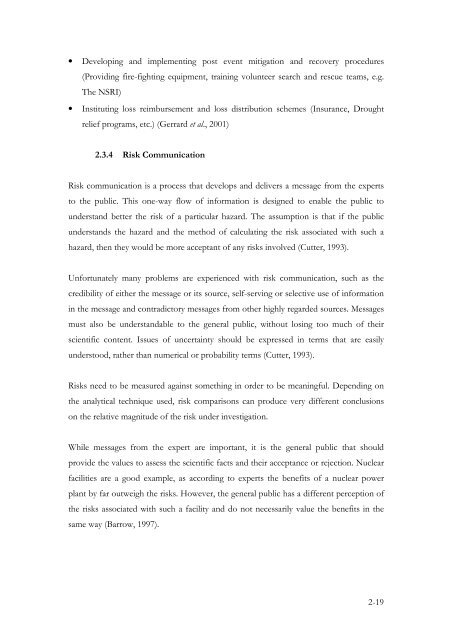A spatial multi-risk hazard assessment and vulnerability study of ...
A spatial multi-risk hazard assessment and vulnerability study of ...
A spatial multi-risk hazard assessment and vulnerability study of ...
You also want an ePaper? Increase the reach of your titles
YUMPU automatically turns print PDFs into web optimized ePapers that Google loves.
• Developing <strong>and</strong> implementing post event mitigation <strong>and</strong> recovery procedures<br />
(Providing fire-fighting equipment, training volunteer search <strong>and</strong> rescue teams, e.g.<br />
The NSRI)<br />
• Instituting loss reimbursement <strong>and</strong> loss distribution schemes (Insurance, Drought<br />
relief programs, etc.) (Gerrard et al., 2001)<br />
2.3.4 Risk Communication<br />
Risk communication is a process that develops <strong>and</strong> delivers a message from the experts<br />
to the public. This one-way flow <strong>of</strong> information is designed to enable the public to<br />
underst<strong>and</strong> better the <strong>risk</strong> <strong>of</strong> a particular <strong>hazard</strong>. The assumption is that if the public<br />
underst<strong>and</strong>s the <strong>hazard</strong> <strong>and</strong> the method <strong>of</strong> calculating the <strong>risk</strong> associated with such a<br />
<strong>hazard</strong>, then they would be more acceptant <strong>of</strong> any <strong>risk</strong>s involved (Cutter, 1993).<br />
Unfortunately many problems are experienced with <strong>risk</strong> communication, such as the<br />
credibility <strong>of</strong> either the message or its source, self-serving or selective use <strong>of</strong> information<br />
in the message <strong>and</strong> contradictory messages from other highly regarded sources. Messages<br />
must also be underst<strong>and</strong>able to the general public, without losing too much <strong>of</strong> their<br />
scientific content. Issues <strong>of</strong> uncertainty should be expressed in terms that are easily<br />
understood, rather than numerical or probability terms (Cutter, 1993).<br />
Risks need to be measured against something in order to be meaningful. Depending on<br />
the analytical technique used, <strong>risk</strong> comparisons can produce very different conclusions<br />
on the relative magnitude <strong>of</strong> the <strong>risk</strong> under investigation.<br />
While messages from the expert are important, it is the general public that should<br />
provide the values to assess the scientific facts <strong>and</strong> their acceptance or rejection. Nuclear<br />
facilities are a good example, as according to experts the benefits <strong>of</strong> a nuclear power<br />
plant by far outweigh the <strong>risk</strong>s. However, the general public has a different perception <strong>of</strong><br />
the <strong>risk</strong>s associated with such a facility <strong>and</strong> do not necessarily value the benefits in the<br />
same way (Barrow, 1997).<br />
2-19
















